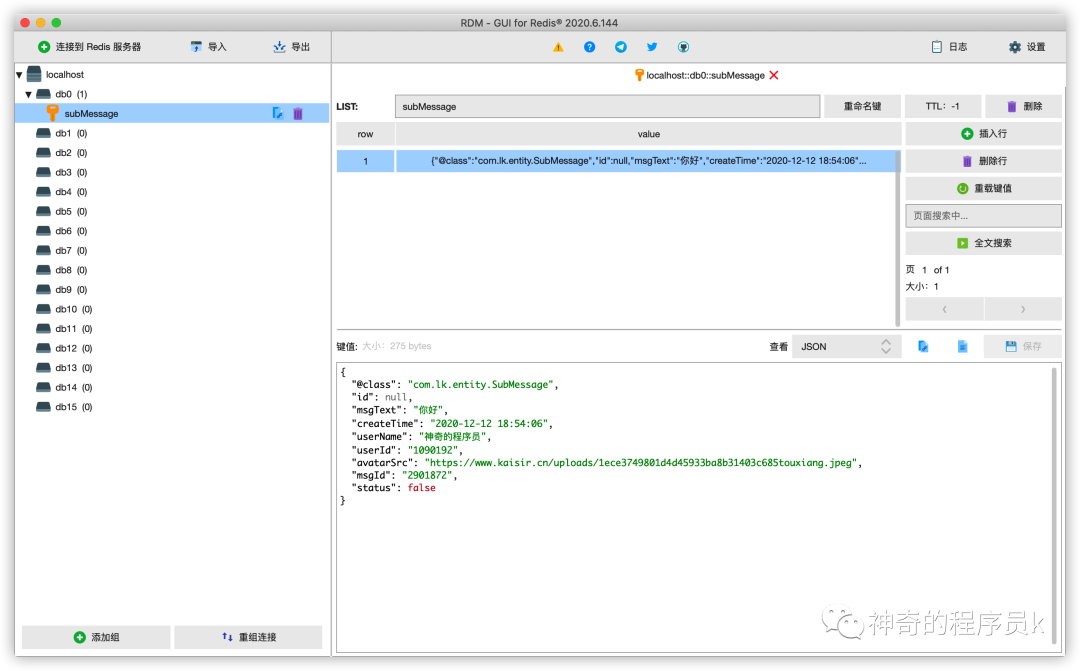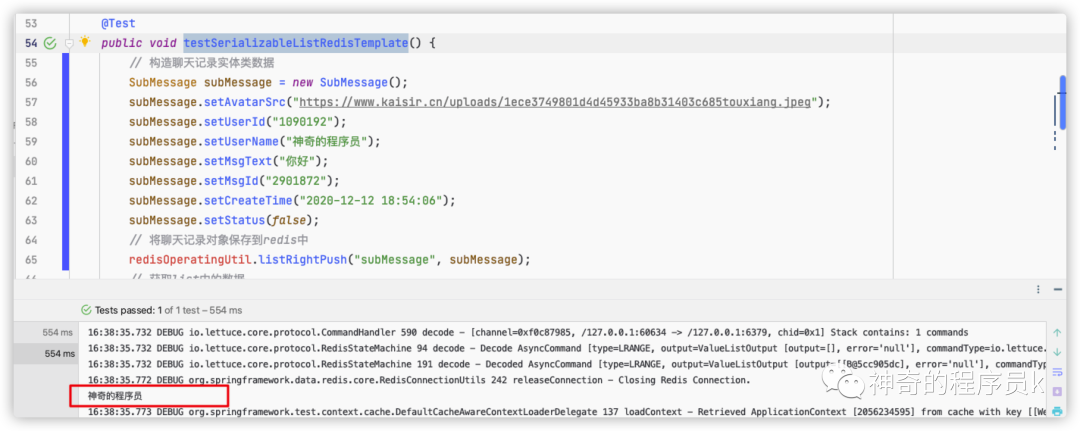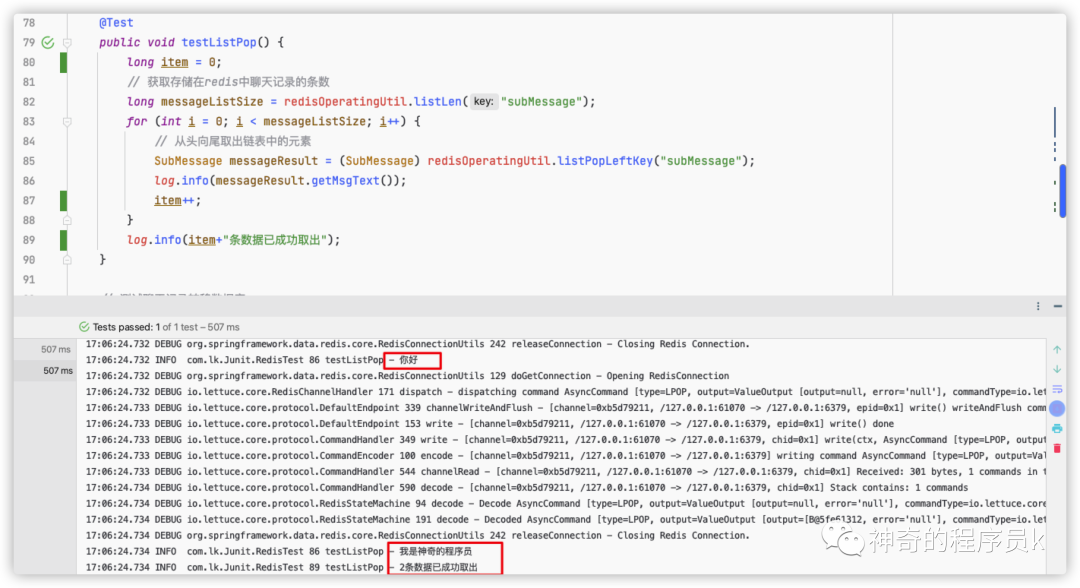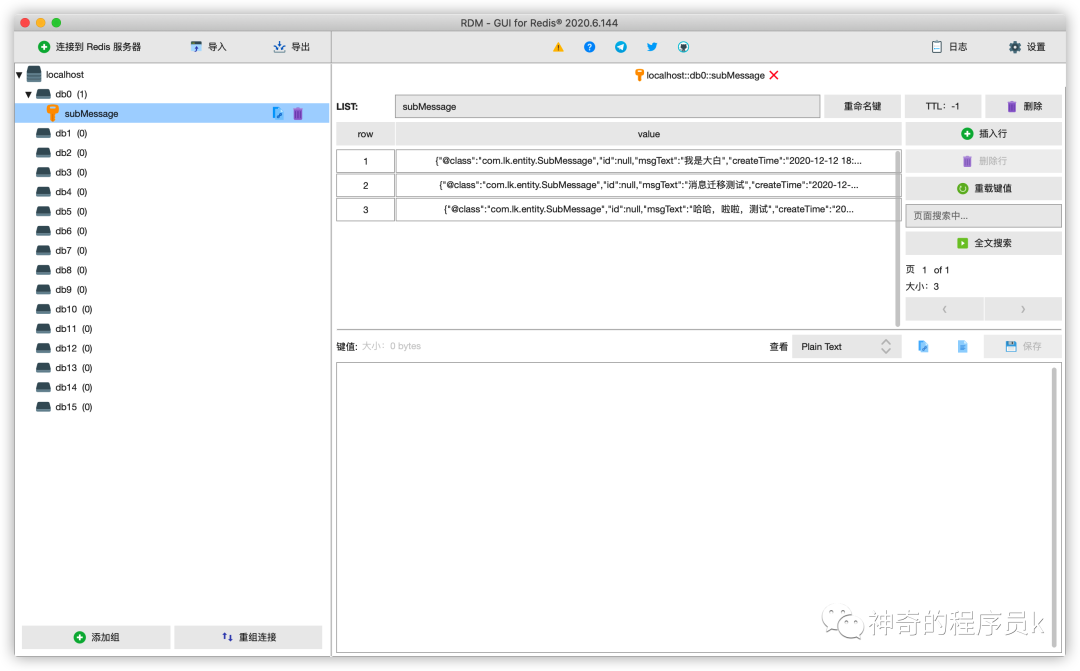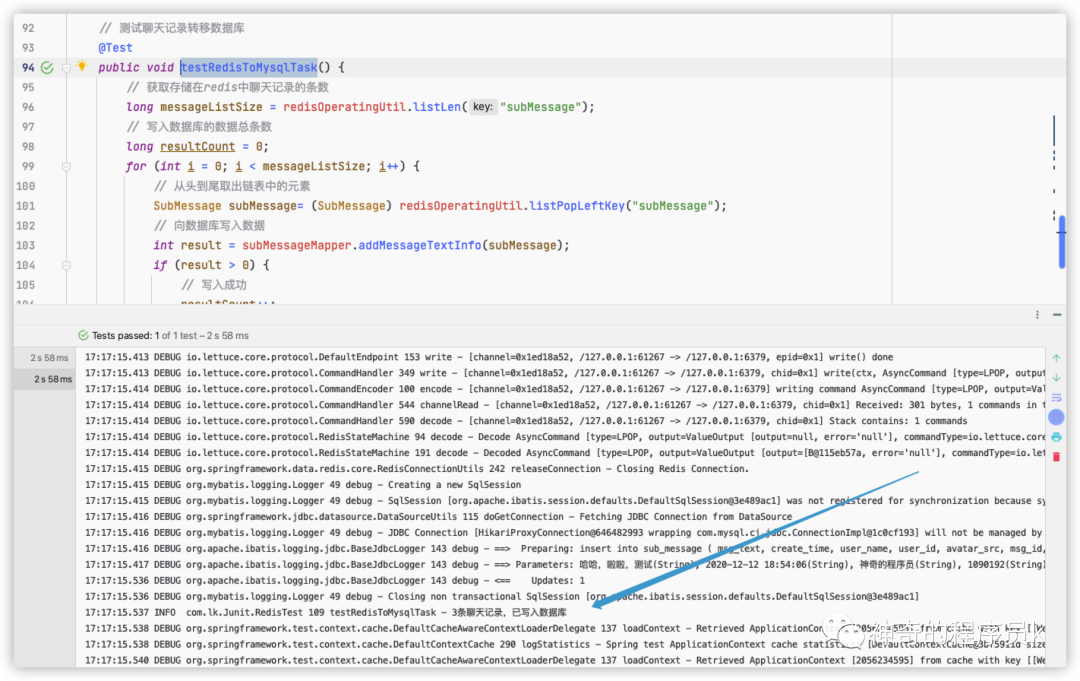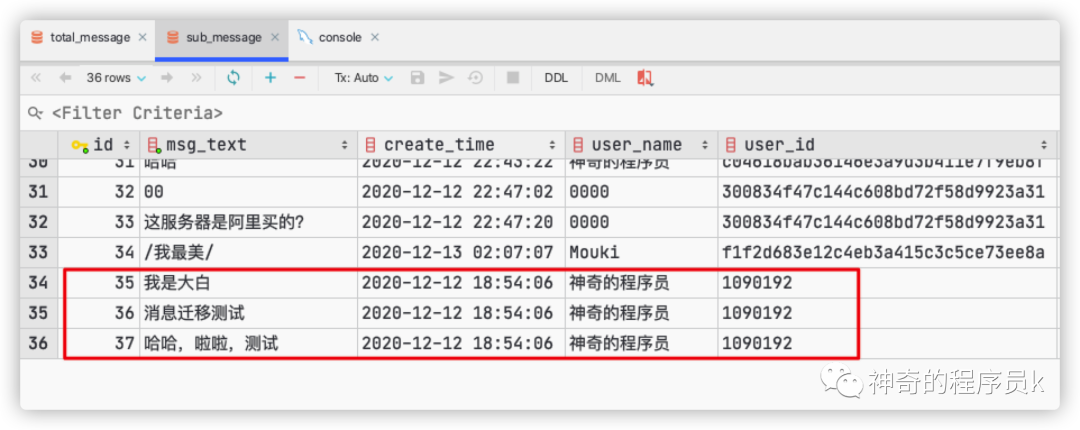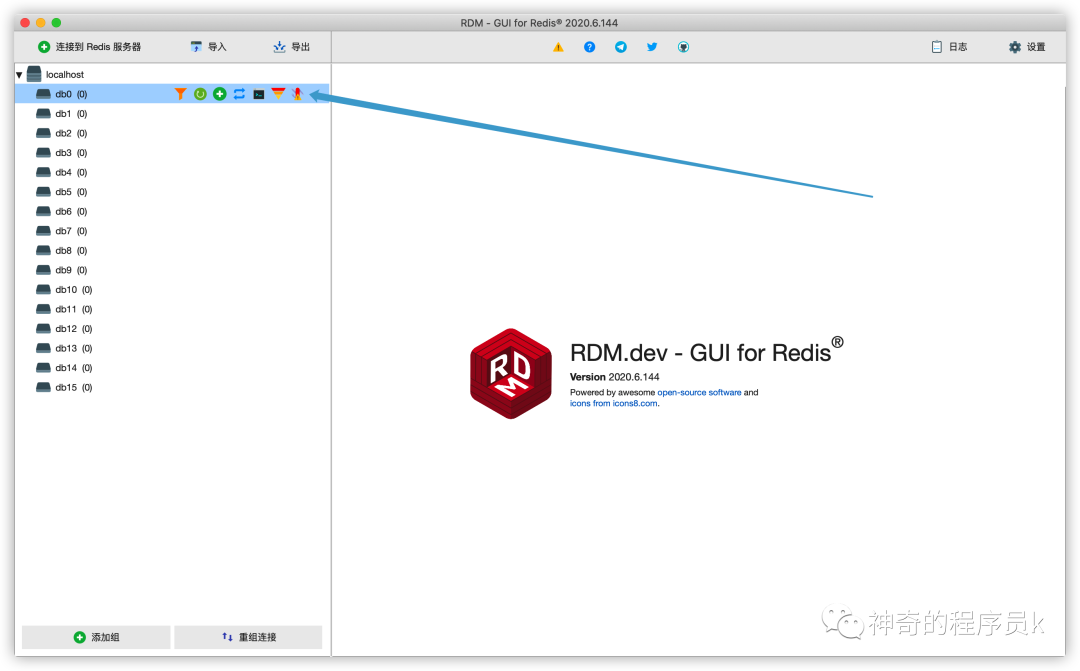使用Redis實現(xiàn)聊天記錄轉(zhuǎn)存
本文轉(zhuǎn)載自微信公眾號「 神奇的程序員K」,作者 神奇的程序員K 。轉(zhuǎn)載本文請聯(lián)系 神奇的程序員K公眾號。
前言
這幾天在實現(xiàn)我開源項目的單聊功能,在實現(xiàn)過程中遇到了需要將聊天記錄保存至數(shù)據(jù)庫的問題,在收到消息時肯定不能直接存數(shù)據(jù)庫,因為這樣在高并發(fā)的場景下,數(shù)據(jù)庫就炸了。
于是,我就想到了redis這個東西,第一次聽說它是在2年前,但是一直沒時間玩他,現(xiàn)在終于遇到了需要使用它的場景,在用的時候?qū)W它,本文就跟大家分享下我的實現(xiàn)思路以及過程,歡迎各位感興趣的開發(fā)者閱讀本文。
環(huán)境搭建
我的項目是基于SpringBoot2.x搭建的,電腦已經(jīng)安裝了redis,用的maven作為jar包管理工具,所以只需要在maven中添加需要的依賴包即可,如果你用的是其他管理工具,請自行查閱如何添加依賴。
本文需要用到依賴:Redis 、quartz,在pom.xml文件的dependencies標簽下添加下述代碼。
- <!-- Redis -->
- <dependency>
- <groupId>org.springframework.boot</groupId>
- <artifactId>spring-boot-starter-data-redis</artifactId>
- </dependency>
- <!-- 定時任務調(diào)度 -->
- <dependency>
- <groupId>org.springframework.boot</groupId>
- <artifactId>spring-boot-starter-quartz</artifactId>
- <version>2.3.7.RELEASE</version>
- </dependency>
在application.yml文件中配置相關(guān)參數(shù)。
- spring:
- # redis配置
- redis:
- host: 127.0.0.1 # redis地址
- port: 6379 # 端口號
- password: # 密碼
- timeout: 3000 # 連接超時時間,單位毫秒
實現(xiàn)思路
在websocket的服務中,收到客戶端推送的消息后,我們對數(shù)據(jù)進行解析,構(gòu)造聊天記錄實體類,將其保存至redis中,最后我們使用quartz設(shè)置定時任務將redis的數(shù)據(jù)定時寫入mysql中。
我們將上述思路進行下整理:
- 解析客戶端數(shù)據(jù),構(gòu)造實體類
- 將數(shù)據(jù)保存至redis
- 使用quartz將redis中的數(shù)據(jù)定時寫入mysql
實現(xiàn)過程
實現(xiàn)思路很簡單,難在如何將實體類數(shù)據(jù)保存至redis,我們需要把redis這一塊配置好后,才能繼續(xù)實現(xiàn)我們的業(yè)務需求。
redis支持的數(shù)據(jù)結(jié)構(gòu)類型有:
- set 集合,string類型的無序集合,元素不允許重復
- hash 哈希表,鍵值對的集合,用于存儲對象
- list 列表,鏈表結(jié)構(gòu)
- zset有序集合
- string 字符串,最基本的數(shù)據(jù)類型,可以包含任何數(shù)據(jù),比如一個序列化的對象,它的字符串大小上限是512MB
redis的客戶端分為jedis 和 lettuce,在SpringBoot2.x中默認客戶端是使用lettuce實現(xiàn)的,因此我們不用做過多配置,在使用的時候通過RedisTemplate.xxx來對redis進行操作即可。
自定義RedisTemplate
在RedisTemplate中,默認是使用Java字符串序列化,將字符串存入redis后可讀性很差,因此,我們需要對他進行自定義,使用Jackson 序列化,以 JSON 方式進行存儲。
我們在項目的config包下,創(chuàng)建一個名為LettuceRedisConfig的Java文件,我們再此文件中配置其默認序列化規(guī)則,它的代碼如下:
- package com.lk.config;
- import org.springframework.context.annotation.Bean;
- import org.springframework.context.annotation.Configuration;
- import org.springframework.data.redis.connection.RedisConnectionFactory;
- import org.springframework.data.redis.core.RedisTemplate;
- import org.springframework.data.redis.serializer.GenericJackson2JsonRedisSerializer;
- import org.springframework.data.redis.serializer.StringRedisSerializer;
- // 自定義RedisTemplate設(shè)置序列化器, 方便轉(zhuǎn)換redis中的數(shù)據(jù)與實體類互轉(zhuǎn)
- @Configuration
- public class LettuceRedisConfig {
- /**
- * Redis 序列化配置
- */
- @Bean
- public RedisTemplate<String, Object> redisTemplate(RedisConnectionFactory connectionFactory) {
- RedisTemplate<String, Object> redisTemplate = new RedisTemplate<>();
- redisTemplate.setConnectionFactory(connectionFactory);
- // 使用GenericJackson2JsonRedisSerializer替換默認序列化
- GenericJackson2JsonRedisSerializer jackson2JsonRedisSerializer = new GenericJackson2JsonRedisSerializer();
- // 設(shè)置 Key 和 Value 的序列化規(guī)則
- redisTemplate.setKeySerializer(new StringRedisSerializer());
- redisTemplate.setValueSerializer(jackson2JsonRedisSerializer);
- redisTemplate.setHashKeySerializer(new StringRedisSerializer());
- redisTemplate.setHashValueSerializer(jackson2JsonRedisSerializer);
- // 初始化 RedisTemplate 序列化完成
- redisTemplate.afterPropertiesSet();
- return redisTemplate;
- }
- }
封裝redis工具類
做完上述操作后,通過RedisTemplate存儲到redis中的數(shù)據(jù)就是json形式的了,接下來我們對其常用的操作封裝成工具類,方便我們在項目中使用。
在Utils包中創(chuàng)建一個名為RedisOperatingUtil,其代碼如下:
- package com.lk.utils;
- import org.springframework.data.redis.connection.DataType;
- import org.springframework.data.redis.core.RedisTemplate;
- import org.springframework.stereotype.Component;
- import javax.annotation.Resource;
- import java.util.Arrays;
- import java.util.Collections;
- import java.util.List;
- import java.util.Map;
- import java.util.concurrent.TimeUnit;
- @Component
- // Redis操作工具類
- public class RedisOperatingUtil {
- @Resource
- private RedisTemplate<Object, Object> redisTemplate;
- /**
- * 指定 key 的過期時間
- *
- * @param key 鍵
- * @param time 時間(秒)
- */
- public void setKeyTime(String key, long time) {
- redisTemplate.expire(key, time, TimeUnit.SECONDS);
- }
- /**
- * 根據(jù) key 獲取過期時間(-1 即為永不過期)
- *
- * @param key 鍵
- * @return 過期時間
- */
- public Long getKeyTime(String key) {
- return redisTemplate.getExpire(key, TimeUnit.SECONDS);
- }
- /**
- * 判斷 key 是否存在
- *
- * @param key 鍵
- * @return 如果存在 key 則返回 true,否則返回 false
- */
- public Boolean hasKey(String key) {
- return redisTemplate.hasKey(key);
- }
- /**
- * 刪除 key
- *
- * @param key 鍵
- */
- public Long delKey(String... key) {
- if (key == null || key.length < 1) {
- return 0L;
- }
- return redisTemplate.delete(Arrays.asList(key));
- }
- /**
- * 獲取 Key 的類型
- *
- * @param key 鍵
- */
- public String keyType(String key) {
- DataType dataType = redisTemplate.type(key);
- assert dataType != null;
- return dataType.code();
- }
- /**
- * 批量設(shè)置值
- *
- * @param map 要插入的 key value 集合
- */
- public void barchSet(Map<String, Object> map) {
- redisTemplate.opsForValue().multiSet(map);
- }
- /**
- * 批量獲取值
- *
- * @param list 查詢的 Key 列表
- * @return value 列表
- */
- public List<Object> batchGet(List<String> list) {
- return redisTemplate.opsForValue().multiGet(Collections.singleton(list));
- }
- /**
- * 獲取指定對象類型key的值
- *
- * @param key 鍵
- * @return 值
- */
- public Object objectGetKey(String key) {
- return redisTemplate.opsForValue().get(key);
- }
- /**
- * 設(shè)置對象類型的數(shù)據(jù)
- *
- * @param key 鍵
- * @param value 值
- */
- public void objectSetValue(String key, Object value) {
- redisTemplate.opsForValue().set(key, value);
- }
- /**
- * 向list的頭部插入一條數(shù)據(jù)
- *
- * @param key 鍵
- * @param value 值
- */
- public Long listLeftPush(String key, Object value) {
- return redisTemplate.opsForList().leftPush(key, value);
- }
- /**
- * 向list的末尾插入一條數(shù)據(jù)
- *
- * @param key 鍵
- * @param value 值
- */
- public Long listRightPush(String key, Object value) {
- return redisTemplate.opsForList().rightPush(key, value);
- }
- /**
- * 向list頭部添加list數(shù)據(jù)
- *
- * @param key 鍵
- * @param value 值
- */
- public Long listLeftPushAll(String key, List<Object> value) {
- return redisTemplate.opsForList().leftPushAll(key, value);
- }
- /**
- * 向list末尾添加list數(shù)據(jù)
- *
- * @param key 鍵
- * @param value 值
- */
- public Long listRightPushAll(String key, List<Object> value) {
- return redisTemplate.opsForList().rightPushAll(key, value);
- }
- /**
- * 通過索引設(shè)置list元素的值
- *
- * @param key 鍵
- * @param index 索引
- * @param value 值
- */
- public void listIndexSet(String key, long index, Object value) {
- redisTemplate.opsForList().set(key, index, value);
- }
- /**
- * 獲取列表指定范圍內(nèi)的list元素,正數(shù)則表示正向查找,負數(shù)則倒敘查找
- *
- * @param key 鍵
- * @param start 開始
- * @param end 結(jié)束
- * @return boolean
- */
- public Object listRange(String key, long start, long end) {
- return redisTemplate.opsForList().range(key, start, end);
- }
- /**
- * 從列表前端開始取出數(shù)據(jù)
- *
- * @param key 鍵
- * @return 結(jié)果數(shù)組對象
- */
- public Object listPopLeftKey(String key) {
- return redisTemplate.opsForList().leftPop(key);
- }
- /**
- * 從列表末尾開始遍歷取出數(shù)據(jù)
- *
- * @param key 鍵
- * @return 結(jié)果數(shù)組
- */
- public Object listPopRightKey(String key) {
- return redisTemplate.opsForList().rightPop(key);
- }
- /**
- * 獲取list長度
- *
- * @param key 鍵
- * @return 列表長度
- */
- public Long listLen(String key) {
- return redisTemplate.opsForList().size(key);
- }
- /**
- * 通過索引獲取list中的元素
- *
- * @param key 鍵
- * @param index 索引(index>=0時,0 表頭,1 第二個元素,依次類推;index<0時,-1,表尾,-2倒數(shù)第二個元素,依次類推)
- * @return 列表中的元素
- */
- public Object listIndex(String key, long index) {
- return redisTemplate.opsForList().index(key, index);
- }
- /**
- * 移除list元素
- *
- * @param key 鍵
- * @param count 移除數(shù)量("負數(shù)"則從列表倒敘查找刪除 count 個對應的值; "整數(shù)"則從列表正序查找刪除 count 個對應的值;)
- * @param value 值
- * @return 成功移除的個數(shù)
- */
- public Long listRem(String key, long count, Object value) {
- return redisTemplate.opsForList().remove(key, count, value);
- }
- /**
- * 截取指定范圍內(nèi)的數(shù)據(jù), 移除不是范圍內(nèi)的數(shù)據(jù)
- * @param key 操作的key
- * @param start 截取開始位置
- * @param end 截取激素位置
- */
- public void listTrim(String key, long start, long end) {
- redisTemplate.opsForList().trim(key, start, end);
- }
- }
進行單元測試
做完上述操作后,最難弄的一關(guān)我們就已經(jīng)搞定了,接下來我們來對一會需要使用的方法進行單元測試,確保其能夠正常運行。
創(chuàng)建一個名為RedisTest的Java文件,注入需要用到的相關(guān)類。
- redisOperatingUtil為我們的redis工具類
- subMessageMapper為聊天記錄表的dao層
- @RunWith(SpringRunner.class)
- @SpringBootTest
- @Slf4j
- public class RedisTest {
- @Resource
- private RedisOperatingUtil redisOperatingUtil;
- @Resource
- private SubMessageMapper subMessageMapper;
- }
接下來,我們看下SubMessage實體類的代碼。
- package com.lk.entity;
- import lombok.AllArgsConstructor;
- import lombok.Getter;
- import lombok.NoArgsConstructor;
- import lombok.Setter;
- @Getter
- @Setter
- @NoArgsConstructor
- @AllArgsConstructor
- // 聊天記錄-消息內(nèi)容
- public class SubMessage {
- private Integer id;
- private String msgText; // 消息內(nèi)容
- private String createTime; // 創(chuàng)建時間
- private String userName; // 用戶名
- private String userId; // 推送方用戶id
- private String avatarSrc; // 推送方頭像
- private String msgId; // 接收方用戶id
- private Boolean status; // 消息狀態(tài)
- }
測試list數(shù)據(jù)的寫入與獲取
在單元測試類內(nèi)部加入下述代碼:
- @Test
- public void testSerializableListRedisTemplate() {
- // 構(gòu)造聊天記錄實體類數(shù)據(jù)
- SubMessage subMessage = new SubMessage();
- subMessage.setAvatarSrc("https://www.kaisir.cn/uploads/1ece3749801d4d45933ba8b31403c685touxiang.jpeg");
- subMessage.setUserId("1090192");
- subMessage.setUserName("神奇的程序員");
- subMessage.setMsgText("你好");
- subMessage.setMsgId("2901872");
- subMessage.setCreateTime("2020-12-12 18:54:06");
- subMessage.setStatus(false);
- // 將聊天記錄對象保存到redis中
- redisOperatingUtil.listRightPush("subMessage", subMessage);
- // 獲取list中的數(shù)據(jù)
- Object resultObj = redisOperatingUtil.listRange("subMessage", 0, redisOperatingUtil.listLen("subMessage"));
- // 將Object安全的轉(zhuǎn)為List
- List<SubMessage> resultList = ObjectToOtherUtil.castList(resultObj, SubMessage.class);
- // 遍歷獲取到的結(jié)果
- if (resultList != null) {
- for (SubMessage message : resultList) {
- System.out.println(message.getUserName());
- }
- }
- }
在上述代碼中,我們從redis中取出的數(shù)據(jù)是Object類型的,我們要將它轉(zhuǎn)換為與之對應的實體類,一開始我是用的類型強轉(zhuǎn),但是idea會報黃色警告,于是就寫了一個工具類用于將Object對象安全的轉(zhuǎn)換為與之對應的類型,代碼如下:
- package com.lk.utils;
- import java.util.ArrayList;
- import java.util.List;
- public class ObjectToOtherUtil {
- public static <T> List<T> castList(Object obj, Class<T> clazz) {
- List<T> result = new ArrayList<>();
- if (obj instanceof List<?>) {
- for (Object o : (List<?>) obj) {
- result.add(clazz.cast(o));
- }
- return result;
- }
- return null;
- }
- }
執(zhí)行后,我們看看redis是否有保存到我們寫入的數(shù)據(jù),如下所示,已經(jīng)成功保存。
image-20201213163924700
我們再來看看,代碼的執(zhí)行結(jié)果,看看有沒有成功獲取到數(shù)據(jù),如下圖所示,也成功取到了。
image-20201213164038308
注意:如果你的項目對websocket進行了啟動配置,可能會導致單元測試失敗,報錯java.lang.IllegalStateException: Failed to load ApplicationContext,解決方案就是注釋掉websocket配置文件中的@Configuration即可。
測試list數(shù)據(jù)的取出
當我們把redis中存儲的數(shù)據(jù)遷移到mysql后,需要刪除redis中的數(shù)據(jù),一開始我用的是它的delete方法,但是他的delete方法只能刪除與之匹配的值,不能選擇一個區(qū)間進行刪除,于是就決定用它的pop方法進行出棧操作。
我們來測試下工具類中的listPopLeftKey方法。
- @Test
- public void testListPop() {
- long item = 0;
- // 獲取存儲在redis中聊天記錄的條數(shù)
- long messageListSize = redisOperatingUtil.listLen("subMessage");
- for (int i = 0; i < messageListSize; i++) {
- // 從頭向尾取出鏈表中的元素
- SubMessage messageResult = (SubMessage) redisOperatingUtil.listPopLeftKey("subMessage");
- log.info(messageResult.getMsgText());
- item++;
- }
- log.info(item+"條數(shù)據(jù)已成功取出");
- }
執(zhí)行結(jié)果如下所示,成功取出了redis中存儲的兩條數(shù)據(jù)。
image-20201213170726492
測試聊天記錄轉(zhuǎn)移至數(shù)據(jù)庫
接下來我們在redis中放入三條數(shù)據(jù)用于測試
image-20201213171623890
我們測試下將redis中的數(shù)據(jù)取出,然后寫入數(shù)據(jù)庫,代碼如下:
- // 測試聊天記錄轉(zhuǎn)移數(shù)據(jù)庫
- @Test
- public void testRedisToMysqlTask() {
- // 獲取存儲在redis中聊天記錄的條數(shù)
- long messageListSize = redisOperatingUtil.listLen("subMessage");
- // 寫入數(shù)據(jù)庫的數(shù)據(jù)總條數(shù)
- long resultCount = 0;
- for (int i = 0; i < messageListSize; i++) {
- // 從頭到尾取出鏈表中的元素
- SubMessage subMessage= (SubMessage) redisOperatingUtil.listPopLeftKey("subMessage");
- // 向數(shù)據(jù)庫寫入數(shù)據(jù)
- int result = subMessageMapper.addMessageTextInfo(subMessage);
- if (result > 0) {
- // 寫入成功
- resultCount++;
- }
- }
- log.info(resultCount+ "條聊天記錄,已寫入數(shù)據(jù)庫");
- }
執(zhí)行結(jié)果如下,數(shù)據(jù)已成功寫入數(shù)據(jù)庫且redis中的數(shù)據(jù)也被刪除。
image-20201213171834299
image-20201213171956311
image-20201213172031222
解析客戶端數(shù)據(jù)保存至redis
完成上述操作后,我們redis那一塊的東西就搞定了,接下來就可以實現(xiàn)將客戶端的數(shù)據(jù)存到redis里了。
這里有個坑,因為websocket服務類中用到了@Component,會導致redis的工具類注入失敗,出現(xiàn)null的情況,解決這個問題需要將當前類名聲明為靜態(tài)變量,然后在init中獲取賦值redis工具類,代碼如下:
- // 解決redis操作工具類注入為null的問題
- public static WebSocketServer webSocketServer;
- @PostConstruct
- public void init() {
- webSocketServer = this;
- webSocketServer.redisOperatingUtil = this.redisOperatingUtil;
- }
在websocket服務的@OnMessage注解中,收到客戶端發(fā)送的消息,我們將其保存到redis中,代碼如下:
- /**
- * 收到客戶端消息后調(diào)用的方法
- *
- * @param message 客戶端發(fā)送過來的消息
- * // @param session 客戶端會話
- */
- @OnMessage
- public void onMessage(String message) {
- // 客戶端發(fā)送的消息
- JSONObject jsReply = new JSONObject(message);
- // 添加在線人數(shù)
- jsReply.put("onlineUsers", getOnlineCount());
- if (jsReply.has("buddyId")) {
- // 獲取推送方id
- String userId = jsReply.getString("userID");
- // 獲取被推送方id
- String buddyId = jsReply.getString("buddyId");
- // 非測試數(shù)據(jù)則推送消息
- if (!buddyId.equals("121710f399b84322bdecc238199d6888")) {
- // 發(fā)送消息至推送方
- this.sendInfo(jsReply.toString(), userId);
- }
- // 構(gòu)造聊天記錄實體類數(shù)據(jù)
- SubMessage subMessage = new SubMessage();
- subMessage.setAvatarSrc(jsReply.getString("avatarSrc"));
- subMessage.setUserId(jsReply.getString("userID"));
- subMessage.setUserName(jsReply.getString("username"));
- subMessage.setMsgText(jsReply.getString("msg"));
- subMessage.setMsgId(jsReply.getString("msgId"));
- subMessage.setCreateTime(DateUtil.getThisTime());
- subMessage.setStatus(false);
- // 將聊天記錄對象保存到redis中
- webSocketServer.redisOperatingUtil.listRightPush("subMessage", subMessage);
- // 發(fā)送消息至被推送方
- this.sendInfo(jsReply.toString(), buddyId);
- }
- }
做完上述操作后,收到客戶端發(fā)送的消息就會自動寫入redis。
定時將redis的數(shù)據(jù)寫入mysql
接下來,我們使用quartz定時向mysql中寫入數(shù)據(jù),他執(zhí)行定時任務的步驟分為2步:
創(chuàng)建任務類編寫任務內(nèi)容
在QuartzConfig文件中設(shè)置定時,執(zhí)行第一步創(chuàng)建的任務。
首先,創(chuàng)建quartzServer包,在其下創(chuàng)建RedisToMysqlTask.java文件,在此文件內(nèi)實現(xiàn)redis寫入mysql的代碼
- package com.lk.quartzServer;
- import com.lk.dao.SubMessageMapper;
- import com.lk.entity.SubMessage;
- import com.lk.utils.RedisOperatingUtil;
- import lombok.extern.slf4j.Slf4j;
- import org.quartz.JobExecutionContext;
- import org.quartz.JobExecutionException;
- import org.springframework.scheduling.quartz.QuartzJobBean;
- import javax.annotation.Resource;
- // 將redis數(shù)據(jù)放進mysql中
- @Slf4j
- public class RedisToMysqlTask extends QuartzJobBean {
- @Resource
- private RedisOperatingUtil redisOperatingUtil;
- @Resource
- private SubMessageMapper subMessageMapper;
- @Override
- protected void executeInternal(JobExecutionContext jobExecutionContext) throws JobExecutionException {
- // 獲取存儲在redis中聊天記錄的條數(shù)
- long messageListSize = redisOperatingUtil.listLen("subMessage");
- // 寫入數(shù)據(jù)庫的數(shù)據(jù)總條數(shù)
- long resultCount = 0;
- for (int i = 0; i < messageListSize; i++) {
- // 從頭到尾取出鏈表中的元素
- SubMessage subMessage= (SubMessage) redisOperatingUtil.listPopLeftKey("subMessage");
- // 向數(shù)據(jù)庫寫入數(shù)據(jù)
- int result = subMessageMapper.addMessageTextInfo(subMessage);
- if (result > 0) {
- // 寫入成功
- resultCount++;
- }
- }
- log.info(resultCount+ "條聊天記錄,已寫入數(shù)據(jù)庫");
- }
- }
在config包下創(chuàng)建QuartzConfig.java文件,創(chuàng)建定時任務
- package com.lk.config;
- import com.lk.quartzServer.RedisToMysqlTask;
- import org.quartz.*;
- import org.springframework.context.annotation.Bean;
- import org.springframework.context.annotation.Configuration;
- /**
- * Quartz定時任務配置
- */
- @Configuration
- public class QuartzConfig {
- @Bean
- public JobDetail RedisToMysqlQuartz() {
- // 執(zhí)行定時任務
- return JobBuilder.newJob(RedisToMysqlTask.class).withIdentity("CallPayQuartzTask").storeDurably().build();
- }
- @Bean
- public Trigger CallPayQuartzTaskTrigger() {
- //cron方式,從每月1號開始,每隔三天就執(zhí)行一次
- return TriggerBuilder.newTrigger().forJob(RedisToMysqlQuartz())
- .withIdentity("CallPayQuartzTask")
- .withSchedule(CronScheduleBuilder.cronSchedule("* * 4 1/3 * ?"))
- .build();
- }
- }
這里我設(shè)置的定時任務是從每月1號開始,每隔三天就執(zhí)行一次,Quartz定時任務采用的是cron表達式,自己算這個比較麻煩,這里推薦一個在線網(wǎng)站,可以很容易的生成表達式:Cron表達式生成器
實現(xiàn)效果
最后,配合Vue實現(xiàn)的瀏覽器端,跟大家展示下實現(xiàn)效果:
效果視頻:使用Vue實現(xiàn)單聊
項目瀏覽器端代碼地址:github/chat-system
項目在線體驗地址:chat-system














